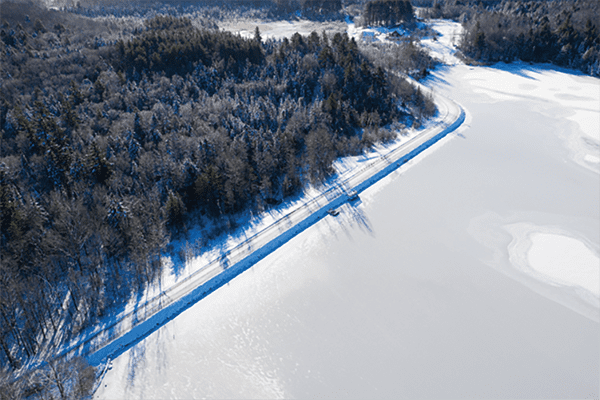Killington’s Kent Pond Dam listed as a ‘significant hazard’
By Katy Savage
A report from the state auditor found several of Vermont’s dams are in poor condition.
Auditor Doug Hoffer completed the report in February, finding some dams have been in poor condition for 18 years and the Dept. of Environmental Conservation (DEC) hasn’t maintained an inventory or completed inspection reports in a timely manner.
“Some of these poor-condition dams, including some owned by the state, are considered high hazard and their poor condition increases the potential to put human lives at risk,”Hoffer said in the report.
There are about 1,262 dams in Vermont, though the DEC estimates that there may be another 1,000 unidentified dams in Vermont not part of the inventory. The age of the dams ranges from seven years old to 232 years old.
Kent Pond Dam in Killington was one of 10 dams selected for review by the auditor. The dam, owned by the Dept. of Fish and Wildlife, is one year past its due date for inspection and is considered a “significant hazard.” It has been listed in “poor” condition since at least 2012.
Kent Pond impounds more than 500,000 cubic feet of water. It was last inspected in 2015 and has remained in poor condition largely due to deferred maintenance problems.
According to its 2015 inspection, a large log is in the primary spillway and brush encroachment is causing water to back up.
“It’s not an immediate safety hazard, it’s preventive maintenance in this case,” said Benjamin Green, a dam safety engineer at the DEC.
Green said more engineering evaluations will be needed to determine a cost estimate to address the issues.
Vermont’s dams are supposed to be inspected every five years, though Green admitted Kent Pond is overdue.
“We do our best to try to get out and do dams on schedule,” said Green, who has been with the state for five years.
Green said part of the problem is that until this year, there were just two people inspecting dams in the state. Two more people were recently hired.
“My main challenge is—even with four people, we are resource-constrained,” Green said.
In 2019, the American Society of Civil Engineers gave Vermont a grade of “C” for dams, in part due to a large number of deteriorating dams, according to a report. Their report said Vermont was fortunate not to have a recent dam failure.

Kent Pond Dam in Killington is listed in “poor” condition and has been for a while, state auditor’s report calls for action.
The American Society of Civil Engineers recommended that DEC increase the staffing back in 2019.
“It’s alarming,” said Sen. Dick McCormack, D-Bethel, of the auditor’s findings. “A lot of dams that are considered vulnerable are not an imminent threat to human lives, but that doesn’t mean you can forget about them.”
McCormack said the dam issues would be discussed in the Legislature.
Dams are considered “low hazard” if their failure would not result in loss of life and cause only minimal property damage. They are a “high hazard” if they would cause loss of more than a few lives and excessive damage to properties or roadways. They are a “significant hazard” if they would cause loss of life to just a few and some damage to homes or public roadways.
The Silver Lake Dam in Barnard, though not listed on the auditor’s report, is considered a “high hazard dam” and listed in “poor” condition by the state. The state-owned dam dates back to the 1800s. Improvements were made in 1968, when the upstream concrete wall was constructed. In 1984, the embankment was improved and in October 2010, the auxiliary spillway was renovated.
The Silver Lake Dam was last inspected in 2019. Unlike the Kent Pond Dam, Green said state regulators check Silver Lake quarterly.
“We’re on that one a lot,” Green said.
The dam is considered “hydraulically inadequate” and doesn’t meet current storm standards, Green said. “That’s not uncommon for these old dams because they were designed to a lesser standard,” he said.
Green said there is about $5 million from the general fund to make improvements to state-owned dams.
“Unfortunately dams were not found eligible by ARPA,” he said.
ARPA, or the American Rescue Plan Act, is a $1.9 trillion Covid stimulus program.
Green said the state will hire consultants to help prioritize where funds are needed.
“We’re going to eventually need to ask for capital funding,” Green said, adding that the state auditor’s report helped identify priority areas. “Some of the recommendations fell in line with our goals,” he said. “We’re in the process of making some of the improvements that were recommended.”
Green said in the dam safety report that some dams are privately-owned, making enforcement difficult. However, he hopes new rules currently being drafted by the DEC will change that.
Act 161 in 2018 directed the DEC to develop rules regarding dam safety, to be completed in July 2022.
“Prior to 2018, we lacked the authority to require dam owners to make changes to their dams in all but the absolute worst case scenarios,” Green explained. “We would make recommendations but we couldn’t force them to make those changes.”
The DEC was given a one-year extension to complete the rules by July 2023.
Anthony Roisman, the chair of the Public Utility Commission, thanked the auditor’s office for the report in a January letter and said action would be taken swiftly. Roisman mentioned the DEC’s upcoming rules in his letter and said his office “will move through the rulemaking process as expeditiously as possible.”



